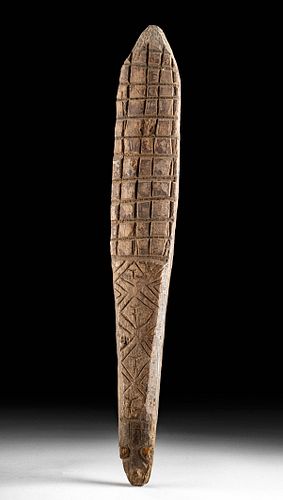20th C. Papua New Guinea Black Palm Wood Tapa Beater
Lot 83a
About Seller
Artemis Fine Arts
686 S Taylor Ave, Ste 106
Louisville, CO 80027
United States
Selling antiquities, ancient and ethnographic art online since 1993, Artemis Gallery specializes in Classical Antiquities (Egyptian, Greek, Roman, Near Eastern), Asian, Pre-Columbian, African / Tribal / Oceanographic art. Our extensive inventory includes pottery, stone, metal, wood, glass and textil...Read more
Categories
Estimate:
$900 - $1,300
Absentee vs Live bid
Two ways to bid:
- Leave a max absentee bid and the platform will bid on your behalf up to your maximum bid during the live auction.
- Bid live during the auction and your bids will be submitted real-time to the auctioneer.
Bid Increments
| Price | Bid Increment |
|---|---|
| $0 | $25 |
| $300 | $50 |
| $1,000 | $100 |
| $2,000 | $250 |
| $5,000 | $500 |
| $10,000 | $1,000 |
| $20,000 | $2,500 |
| $50,000 | $5,000 |
| $100,000 | $10,000 |
| $200,000 | $20,000 |
About Auction
By Artemis Fine Arts
Nov 12, 2020
Set Reminder
2020-11-12 12:00:00
2020-11-12 12:00:00
America/New_York
Bidsquare
Bidsquare : Arms & Armor | Antiquity to Modern Day
https://www.bidsquare.com/auctions/artemis-gallery/arms-armor-antiquity-to-modern-day-6023
Specialty auction featuring axes, mace heads, swords, spears, various types of armor, and more! Many different cultures and price ranges. Great for first-time buyers, seasoned collectors, dealers, and that hard to buy for person on your holiday shopping list. Artemis Fine Arts info@artemisfinearts.com
Specialty auction featuring axes, mace heads, swords, spears, various types of armor, and more! Many different cultures and price ranges. Great for first-time buyers, seasoned collectors, dealers, and that hard to buy for person on your holiday shopping list. Artemis Fine Arts info@artemisfinearts.com
- Lot Description
Oceania, Papua New Guinea, Ramu River region, early 20th century. Skillfully carved from black palm wood, a tapa beater that features a fine carving of a zoomorphic visage at one end - perhaps that of a crocodile presenting ears or eyes raised in relief, a long snout with a nose that is also delineated in relief as well as an open mouth below. Above this, the beater is meticulously incised, perhaps to represent the skin/coat of the animal, with the lower section presenting repeated nested diamond motifs that each house a "Y" or "T" motif, followed by a cross-hatched section with a pointed end. The animal's face as well as the sides and underside of the beater are nicely painted with black striations. A mesmerizing example! Size: 2.125" W at widest point x 14.5" H (5.4 cm x 36.8 cm)
Tapa is a particular kind of bark cloth that is made in the South Pacific Islands. The cloth is of great social importance and is often given as a gift; however, prior to the introduction of synthetic fabrics, it was also used for everyday wear. The process for making it is complex and almost ritualistic. First, the paper mulberry tree is cut, the bark is stripped, and the inner bark retained and sun dried, then soaked. After this, the bark is beaten using a tool like this one. The sound of the tapa being beaten creates a rhythmic musical backdrop as the work is being done. The strips are then beaten together using plant starch to form a large sheet; the edges of this sheet are then trimmed using a knife or sharp shell. Finally, the tapa sheet is beautifully painted using stencils made from coconut.
Provenance: private Newport Beach, California, USA collection
All items legal to buy/sell under U.S. Statute covering cultural patrimony Code 2600, CHAPTER 14, and are guaranteed to be as described or your money back.
A Certificate of Authenticity will accompany all winning bids.
We ship worldwide and handle all shipping in-house for your convenience.
#142264Expected age wear with inactive insect wear/loss to the underside as shown. Normal surface wear and nicks/chips/scuffs to high-pointed areas. Still, the incised and painted decoration are strong.Condition
- Shipping Info
-
All shipping is handled in-house for your convenience. Your invoice from Artemis Gallery will include shipping calculation instructions. If in doubt, please inquire BEFORE bidding for estimated shipping costs for individual items.
-
- Buyer's Premium



 EUR
EUR CAD
CAD AUD
AUD GBP
GBP MXN
MXN HKD
HKD CNY
CNY MYR
MYR SEK
SEK SGD
SGD CHF
CHF THB
THB















